NATIONAL BUILDING REGULATIONS AND BUILDING STANDARDS ACT NO 103 OF 1977 ( as amended ) of jurisdiction, or any part thereof, of any local authority from the application of this Act, or of any provision or provisions thereof which are mentioned in the notice Para (a) substituted by s 2 (a) of Act 36 of 1984 and by s 2 (a) of Act 62 ofApproved Document K, 13 edition Requirement K4 Protection against impact with glazing Protection against impact with glazing K4 Glazing, with which people are likely to come into contact whilst moving in or about the building shall if broken on impact, break in a way which is unlikely to cause injury;Environment under article 7 of the Building Regulations It provides guidance in relation to the revised Part M of the Second Schedule to the Regulations The document should be read in conjunction with the Building Regulations, 1997, and 00 and other documents published under these Regulations In general, Building Regulations apply to the
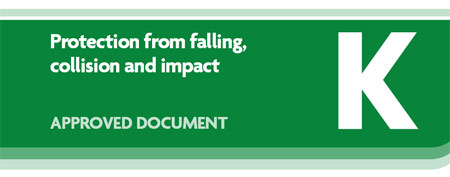
Approved Document K Building Regulations Protection From Collision Including Falling And Impact Diy Doctor
Part k building regs
Part k building regs-Part N and its associated Approved Document N were withdrawn from use in England on 6 April 13, with their requirements and guidance subsumed into Part K of the Buildings Regulations and Approved Document K Protection from falling, collision and impactThe dictated height of the glazed balustrade needed will be determined by the building's use and is detailed in Building Regulations Part K (Diagram 31) These are given in the height of the balustrade above Finished Floor Level (FFL) In a private residential building a balustrade is needed
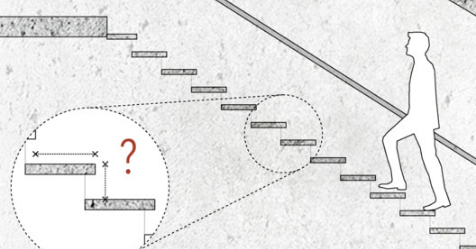



Architecturaltechnologywestminster It S A Good Guide But Don T Forget To Cross Reference With The Building Regulations Part K Depending On The Type Of Building There Is Strict Guidance On Max Min
Technical Guidance Document K Stairways, Ladders, Ramps and Guards From Department of Housing, Local Government and Heritage Published on 7 December Last updated on 7 December 12 days ago Building Regulations 10 Approved Document K, 13 edition iii The Building Regulations The following is a high level summary of the Building Regulations relevant to most types of building work Where there is any doubt you should consult the full text of the regulations, available at wwwlegislationgovuk Building work
Part K of building regulations covers protection from falling, collision and impact This is especially relevant in our industry for handrail heights and balustrade spacing Again we'll ensure our products meet part K and that there no gaps greater than 100mmStairs riser Part K of the building regulations requires that the rise, going, handrails, headroom, length and width of any stairs, ladders and ramps between levels are appropriate to afford reasonable safety to people gaining access to and moving about buildings Approved Document K Protection from falling, collision and impact describesK2 Protection from falling
Technical Guidance Documents are published to accompany each part of the Building Regulations indicating how the requirements of that part can be achieved in practice Adherence to the approach outlined in a Technical Guidance Document is regarded, as evidence of compliance with the requirements of the relevant part of the Building RegulationsApproved Document K Protection from falling, collision and impact Summary 01 This approved document gives guidance on how to comply with Parts K1, K2, K3, K4, K51, K52, K53, K54 and K6 of the Building Regulations It contains the following sections Section 1 Guidance on aspects of the geometry of stairs, special stairs, fixed ladders and handrails for and guarding of stairs8 Approved Document K Building Regulations 10 Draft 13 Edition Introduction Materials and workmanship 07 Any building work which is subject to the requirements imposed by Schedule 1 to the Building Regulations should be carried out in accordance with Regulation 7 Guidance on meeting these requirements on materials and




Practical Post 24 New Part K J Of Building Regulations Bregs Blog



1
Whilst Building Regulations contain a minimum height for guarding to openable windows for the purposes of protection from falling, there is also a maximum height to satisfy means of escape The base of window openings in this case needs to be no more than 1100mm above floor level to satisfy the requirements for escape windows The new Part K of the Building Regulations will come into effect on 1 st of January 15 In general, Building Regulations apply to the construction of new buildings and to extensions and material alterations to buildings In addition, certain parts of the Regulations apply to existing buildings where a material change of use takes placePlease find some notes from Approved Document K of the Building Regulations 1992 Stairs, Ramps and Guards gives provisions for stairways in the design and building of stairways which form part of the structure and guidance on the aspects of geometry and guarding of stairs BS585 Part 1 19 Woodstairs covers specifications for stairs with closed risers for domestic use,
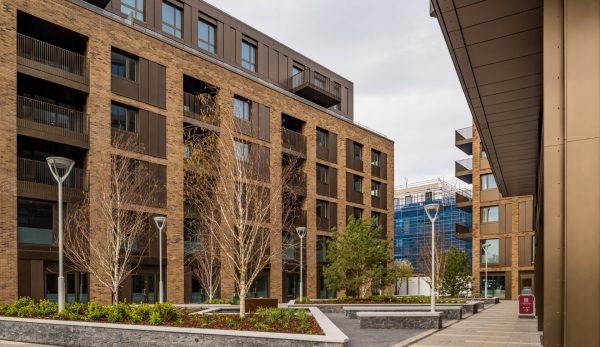



Approved Document K Understanding Balustrade Regulations Part 1




Approved Document K Building Regulations Protection From Collision Including Falling And Impact Diy Doctor
Approved Document K Protection from falling, collision and impact Approved Documents provide guidance on how to meet the building regulations Part K contains guidance on the safety of stairs, guarding, and glazing within and around buildings The Approved Document can be downloaded belowPart K of the Building Regulations states that you don't need a handrail on the first two steps of a staircase, such as on bullnose steps, where the newel post is positioned on the third step You can read the full building regulation requirements for staircases in Part K Building Regulations Protection from falling, collision and impact onBUILDING REGULATIONS GUIDANCE NOTE NHBC BUILDING CONTROL ACCESS TO AND USE OF BUILDINGS – DWELLINGS Parts M and K* to the Building Regulations require that people, regardless of disability, age or gender are able to gain access to buildings and use their facilities, both as visitors and people who live or work in them This guide is intended to




Approved Document K Understanding Balustrade Regulations Part 1
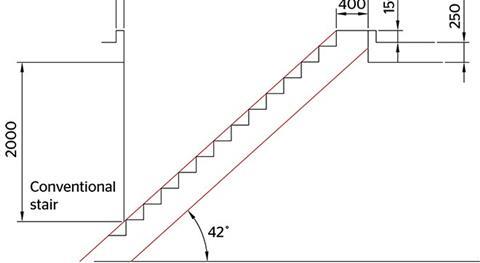



Cpd 17 16 Rooflights And Part K Features Building Design
The UK Building Regulations Approved Document K covers how to prevent injury to any person with a property, whether its a domestic property or place of work The document covers how to correctly construct stairs, ramps and ladders to the correct width and pitch and how any open sides should be coveredBUILDING REGULATIONS, 1997 The Minister for the Environment and Local Government, in exercise of the powers conferred on him by sections 3, 4 and 18 of the Building Control Act, 1990 (No 3 of 1990), hereby makes the following Regulations— 1 Citation 1 These Regulations may be cited as the Building Regulations, 1997 2 Commencement 2Part K Building Regulations The width of stairs Private stairs should have a width of no less than 800mm With semipublic or public stairs, the designers have to be complacent about other regulations as well, including a "means of escape" that has to pass fire safety regulations, as well as providing access to ambulant disabled people




Protection From Falling Collision And Impact Approved Document K Gov Uk
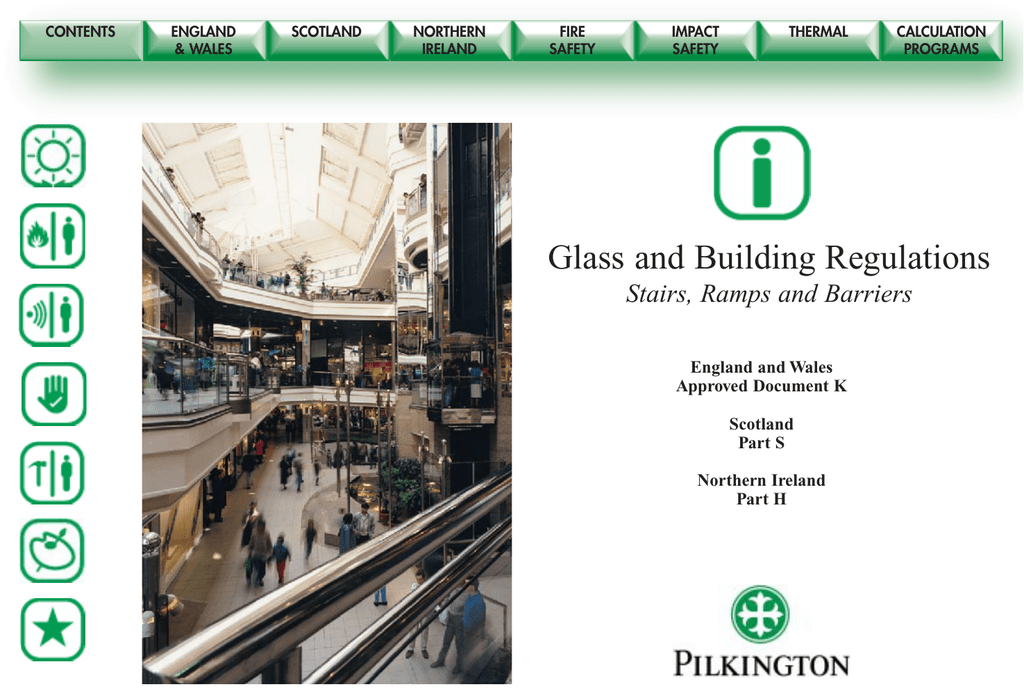



Glass And Building Regulations Stairs
Part K Protection from falling, collision and impact Mezz One follows the design guidance in Approved Document K of the UK building regulations early on in the design stage Similar to the considerations pertaining to fire safety, the design will ensure there is ample access space, proper edge protection, and approved staircasesA webinar held by the Chartered Association of Building Engineers on 25 November 15 looking at the changes to Part M of the Building Regulations Please noApproved Document K Protection from falling, collision and impact Understanding the building regulations and interpreting their requirements for balustrades can be a complex and timeconsuming task This guide focuses specifically on the building regulations Document K



2
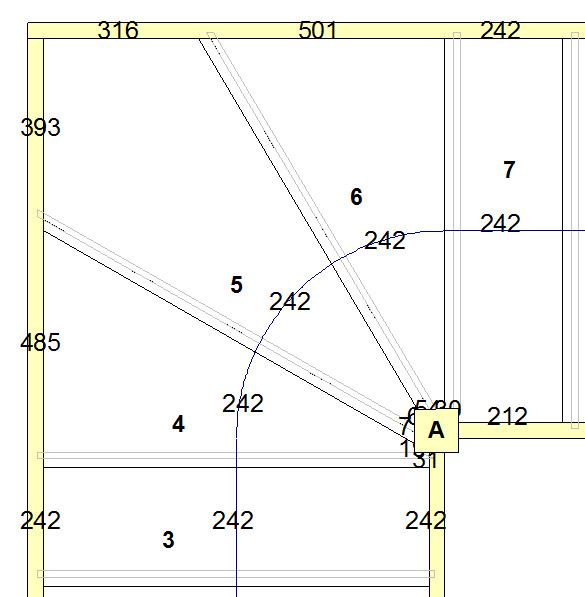



Tkstairs Advise On Domestic Building Regulations
Approved Document K protection from falling, collision and impact Ref ISBN 978 1 484 7 PDF , 1MB This file may not be suitable for users of assistive technologyPart K building regulations is an approved document that forms part of the overall Building Regulations 10 legislation The document relates to the protection from falling, collision and impact on all building works on commercial properties for people who are responsible for building work (eg agent, designer, builder or installer)Building Regulations in Washington, DC ALISON K HOAGLAND An nineteenthcentury Washington the residential building form was the row house Street after street is lined with these row houses, in brick or stone, two, three, or four stories, usually with rhythmic projecting bays The appearance of these row homes is dependent




Approved Document K Free Online Version




Guide To Building Regulations Part K
• You replace or repair any part of your well system • When your well has been flooded Test for nitrate when • A household member is an infant under 12 months old • A household member is pregnant, nursing, or trying to get pregnant • You live in area where fertilizers are, or have been, used near your well Test for arsenic if architects, building regs part K, Building Regulations, commercial building design, rooflights, windows Recommended Posts A Guide to Glazed Extensions for Hotels and Restaurants Bespoke Internal Glazing for One Crown Place Francis Crick Institute opens COVID19 Vaccination CentreGuidance for how to apply the building regulations can be found in the series of Approved Documents This piece looks at what needs to be considered when meeting the requirements of Part K Protection from falling, collision and impact There are three key areas which concern secondary glazing in Approved Document K;




Regulations Explained Uk




Approved Document K Free Online Version
The Building Regulations 10 APPROVED DOCUMENT K PART K PROTECTION FROM FALLING, COLLISION & IMPACT Manifestation in the form of a logo or sign should be a minimum 150mm high • Manifestation in the form of a decorative feature such as 50mm high • Where glass doors may be held open, they should beYes, but a carport, open on at least two sides, or a covered way or similar structure at ground level is exempt, provided it does not exceed 30m2 in areaPart K The Requirement Part K of the Second Schedule to the Building Regulations 1997 to 14 provides as follows This Technical Guidance Document is divided into two sections Section 1 relates to the Requirement K1 and is divided into two parts Subsection 11 deals with stairways and ladders and subsection 12 deals with ramps




Space Saver Stairs And The Building Regulations Space Savers Stairs Space



Stair Regulations Notes From Stairplan Information To Help You With Your New Staircase
Building Regulation Part K for Glazing – Requirement K4 Approved document K of the Building Regulations outlines the requirements for protection from falling, collision and impact This article will focus on requirement K4 which covers protection against impact with glazing Requirement K4 outlines building regulations for both residentialTechnical Guidance Document K Stairways, Ladders, Ramps and Guards(1997) (Reprint May 05) Technical Guidance Document K – Stairways, Ladders, Building regulations guidance part K (protection from falling, collision and impact) Guidance Building regulations guidance part K (protection from falling, collision and impact) Guidance for contractors on the correct design and installation of



Building Regulations 13 Changes To Approved Documents Part K M And P And Amendments To Part B



2
Work described in Part K concerns the safe means of access and egress Work associated with safe means of access and egress covered in these sections may be subject to other relevant Parts of the Building Regulations With reference to the requirements of Part K6 of Schedule 1 of the Building Regulations, reservoirs and water retainingOr resist impact without breaking;The regulations cover all aspects of construction and are constantly reviewed The guidance documents referred to as 'Approved Documents' contain practical ways and explanations of how to comply with the functional requirements of the Building Regulations These 'Approved Documents' are separated into parts Part A Structure



2



2
Requirement K51 Protection from collision with open windows etc Requirement K52 Manifestation of glazing Requirement K53 Safe opening and closing of windows etc Requirement K54 Safe access for cleaning windows etc Requirement K6 Protection against impact from and trapping by doors Section 1 Stairs and laddersBuilding Regulations for Staircases in England & Wales Please find some notes from Approved Document K of the Building Regulations 1992 Stairs, Ramps and Guards gives provisions for stairways in the design and building of stairways which form part of the structure and guidance on the aspects of geometry and guarding of stairsBuilding Regs (K&M), BS00 and BS9266 These state that the tread should measure between 5065mm and the riser 3055mm This ensures there is a large enough 'band' on the nose of the step (Actually there is a small variance between the documents, but the consensus is now that the dimensions as shown meet the requirements)




Pin On Basiclaw Int
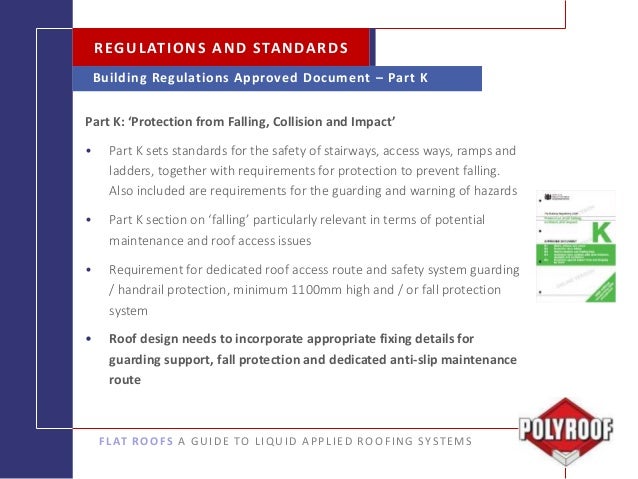



Liquid Solutions For Flat Roofs Polyroof Products Limited Online
Details of Part K (Approved Document K) of the Building Regulations Publication title Approved Document K Protection from falling, collision and impact Date published January 13 ISBN 978 1 484 7 Summary Approved Document K includes advice on protection from falling,This Approved Document deals with the following Requirement from Part K of Schedule 1 to the Building Regulations 10 Where necessary reference should be made to Approved Document B Fire safety, and Approved Document M Access and facilities for disabled people Note Attention is drawn to the Workplace (Health, Safety and WelfareThese regulations, if you go into full detail on them, are very extensive You can read them in their full form on the Government / community websites, but we're going to simplify it for you a little today Very simply, if your project is up against building regulations, then you as a company must comply with the following PART A Structure




Approved Document K Free Online Version



2
Latest Question Do I need to make a Building Control application to build an attached garage?Juliet balconies fall under Part K of the Building Regulations Act 00 1) Gaps in any railings are to be no more than 100mm 2) The top of the balcony must be a minimum of 1100mm from standing floor level This is essential knowledge when choosing and installing a new Juliet balconyDetails of Part H (Approved Document H) of the Building Regulations Publication title Approved Document H Drainage and Waste Disposal (15 edition) Date published March 15 Date valid from 1 October 15 Summary Approved Document H offers guidance on drainage including foul and surface water and rainwater, and sanitary waste disposal, including sewage structures and



2




Approved Document K Free Online Version




Document K Building Regulations 1991 Isle Of Man Been Simplified To Refer Only To Bs 5395 Part



2




Document K Building Regulations 1991 Isle Of Man Been Simplified To Refer Only To Bs 5395




Approved Document K Free Online Version
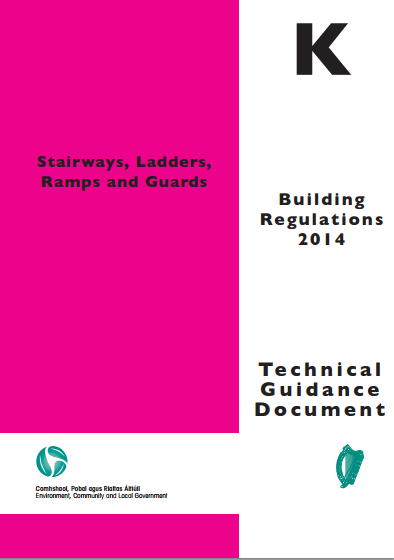



Tgd Part K 14 Property Health Check




Building Regulation Part K Requirement K5 Commercial Architectural Structural Glazing Contractors




Building Regulations For Windows And Doors



Sans K The Application Of The National Building Regulations Part K Walls South African Bureau Of Standards Free Download Borrow And Streaming Internet Archive




Approved Document K Free Online Version



Buidling Regulations Staircases 1998 Part K
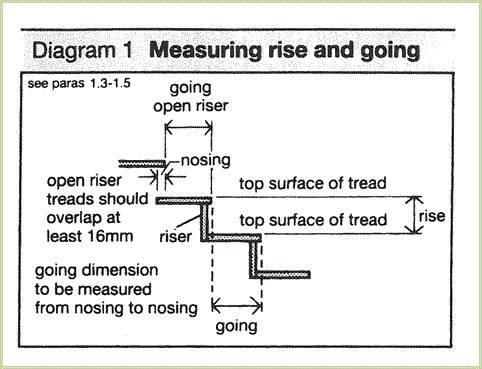



Building Regulations 10 K



Building Act 1984 Building Regulations Amendment Regulations 1997 New Parts K And N In Schedule 1 To The Building Regulations 1991 The Construction Information Service




Guide To Building Regulations Part K



3
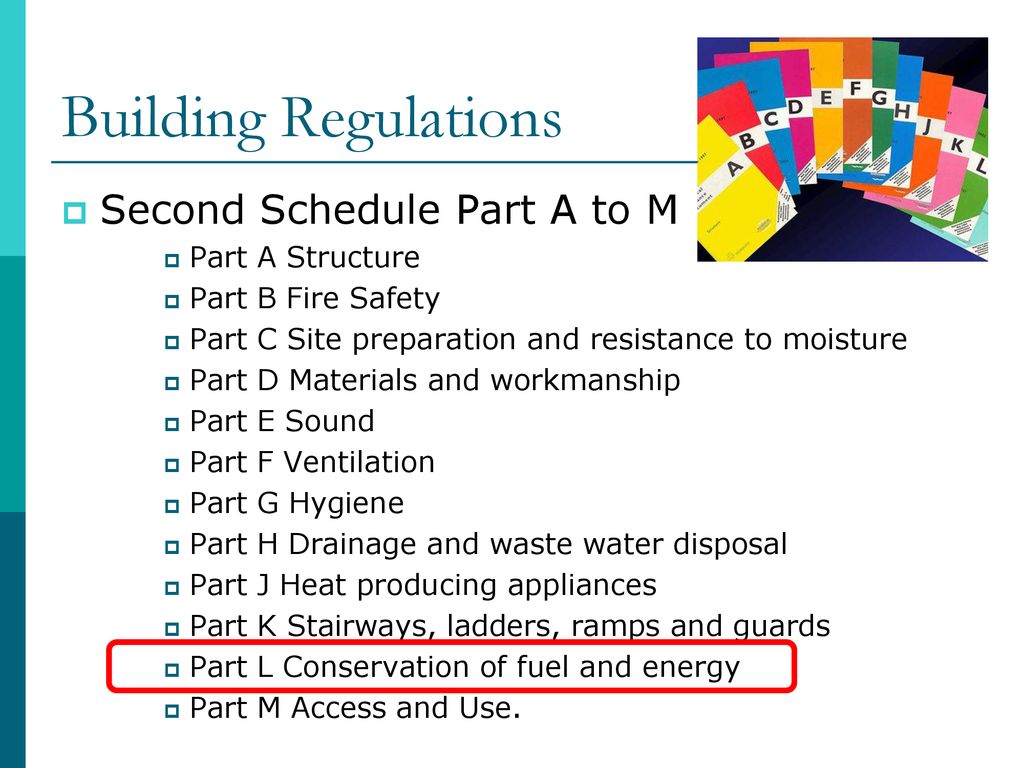



Environmental Services Training Group Ppt Download



2




Building Regulations 10 K 1
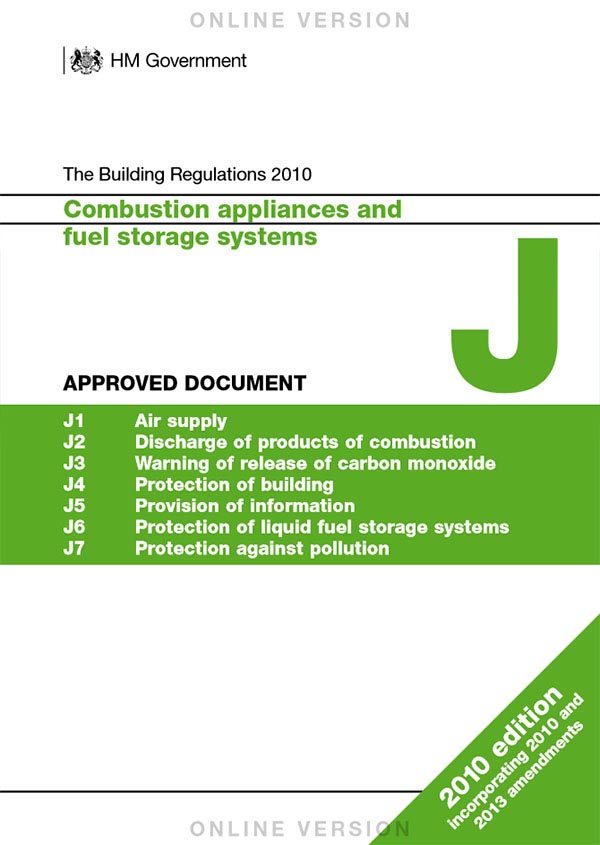



Building Regulations Approved Documents




Approved Document K Building Regulations Protection From Collision Including Falling And Impact Diy Doctor



The New Part K Of The Building Regulations Bregsforum



Protection From Falling Collision And Impact The Building Regulations Edition For Use In England Online Version Approved Document Pdf Free Download
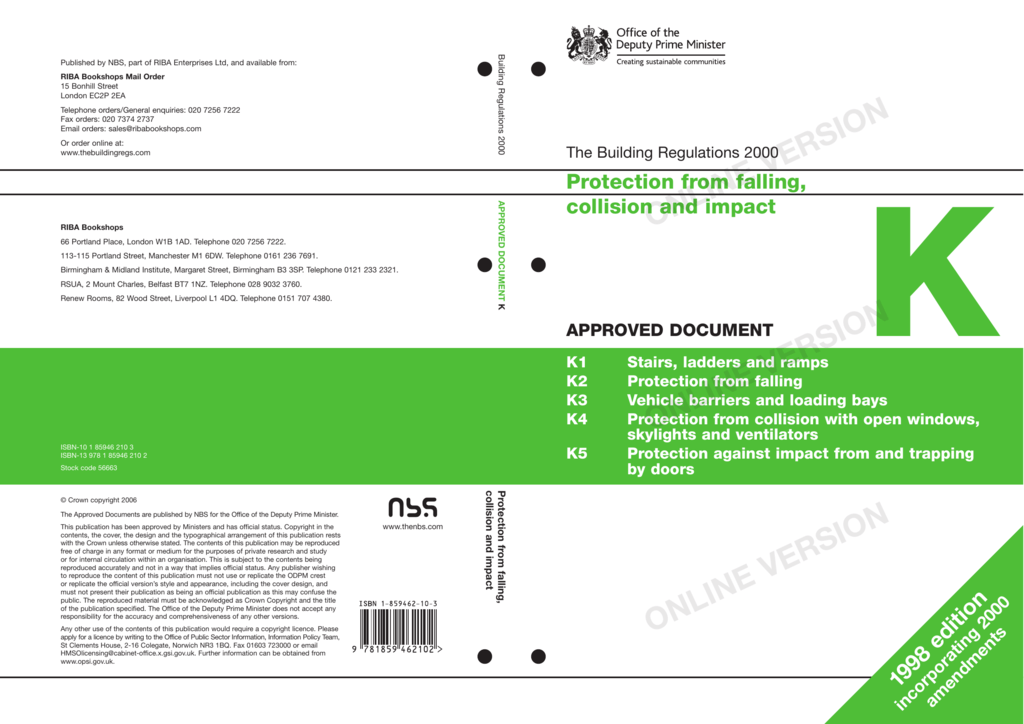



Part K Planning Portal




Building Regulations Pocket Book 1st Edition Ray Tricker Samant




Approved Document K Free Online Version




Building Regulations For Stairs In Ireland George Quinn Stair Parts Plus




Building Regulation Part K Requirement K5 Commercial Architectural Structural Glazing Contractors




Architecturaltechnologywestminster It S A Good Guide But Don T Forget To Cross Reference With The Building Regulations Part K Depending On The Type Of Building There Is Strict Guidance On Max Min



Building Regulations Document K 13 Stairs




Factors Affecting The Usability Of Stairs Dr Michael Wright 21st October Ppt Download
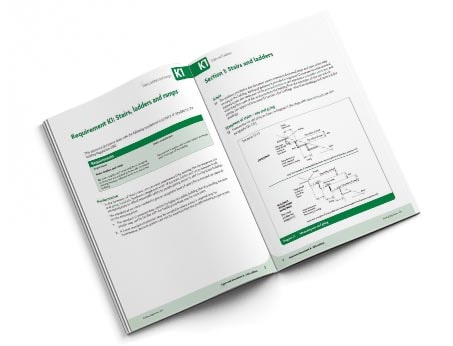



Staircase Regulations Document K Help And Guides Stairbox




Approved Document K Free Online Version



2




Approved Document K Free Online Version



2




Part K Building Regulations Commerical Staircases Essential Projects




Advise On Domestic Building Regulations Building Regulators Floor Plans




Thermal Testing Building Regulations U Values Life Cycle




Handrail Height What Height Should A Staircase Handrail Be




Approved Document K Free Online Version




Approved Document K Free Online Version



Building Regulations For Staircases Part K




Building Regulations Guidance Part K Protection From Falling Collision And Impact Gov Wales




Regulations Explained Uk




Building Regulation Part K For Glazing Requirement K4



What Is The Required Angle For A Staircase In Domestic Building Quora




Approved Document K Free Online Version



Wrought Iron Gates Railings Juliet Balconies Custom Made Metal Work
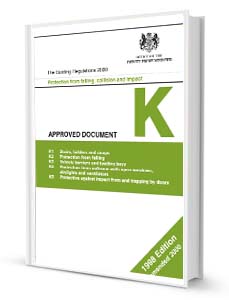



Staircase Information Help And Information




Building Regulation Part K For Glazing Requirement K4




Building Regs Part K Commercial Architectural Structural Glazing Contractors




Approved Document K Free Online Version
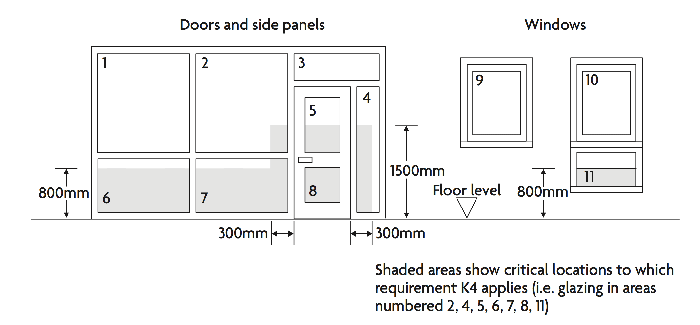



Approved Document Part K




Application Of The National Building Regulations Part K Walls Sans K Van Schaik
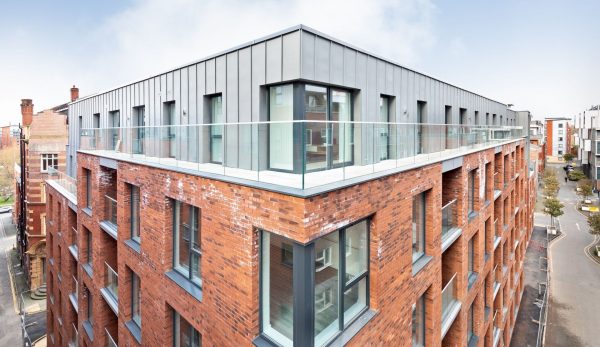



Approved Document K Understanding Balustrade Regulations Part 1




Approved Document K Free Online Version




Safer Mezzanine Floors Pdf Safety Regulatory Compliance




Stairs And Landing Ideas From Houseology The House Design Experts




Approved Document K Free Online Version
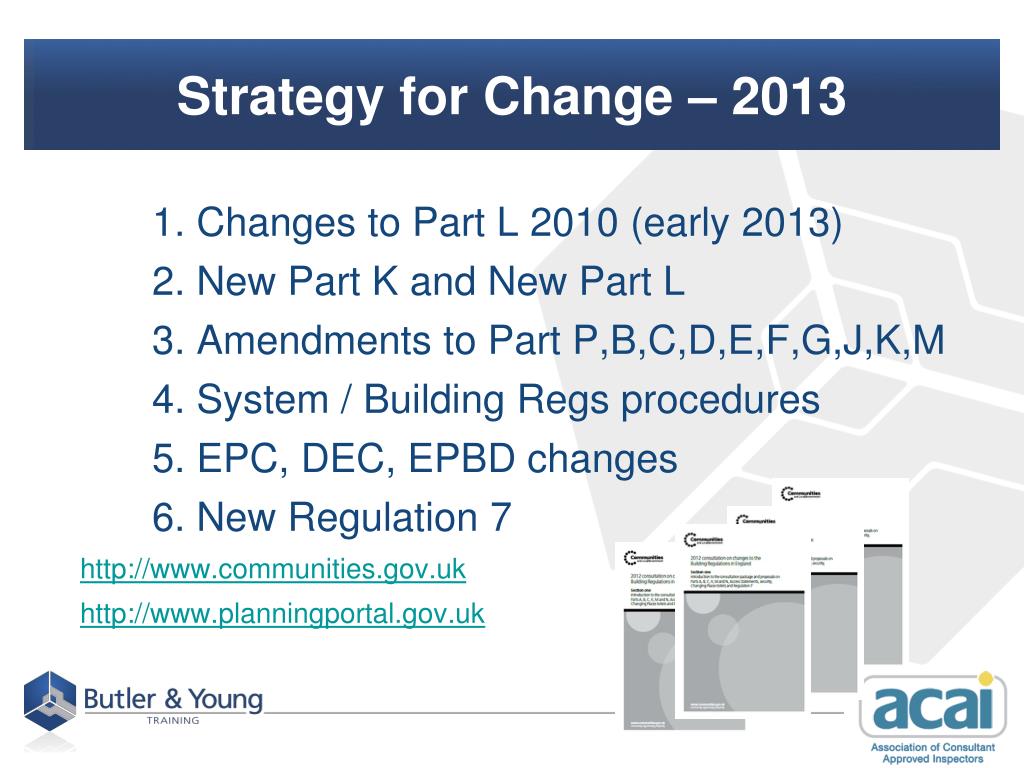



Ppt Building Regulations Current And Future Changes Powerpoint Presentation Id




Safety Glazeit



Tcm Access Consultants Guidance Building Regulations




Approved Document K Free Online Version



The New Part K Of The Building Regulations Bregsforum




Approved Document K Free Online Version



The New Part K Of The Building Regulations Bregsforum




Building Regulations Electrical Safety Jan 05




Yesterdays Roomtoimprove A Comment On Building Regulations Forthcoming Amendments Bregsforum Mark Stephens Architects
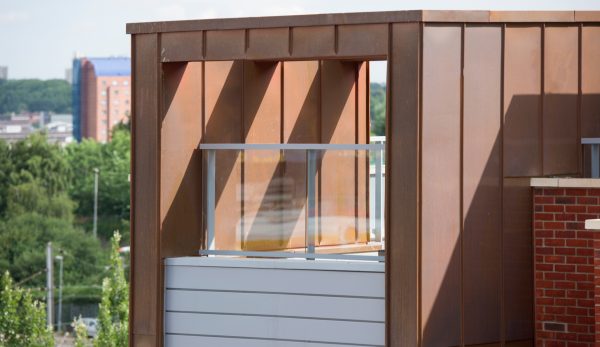



Approved Document K Understanding Balustrade Regulations Part 1



2




Building Regulations 10 K 1



Part




Approved Document M Entering A Building



Stair Width Dimensions




Ranting Again About Stairs Isabel Barros Architects Blog




Approved Document K Free Online Version




Building Regulations 10 K 1
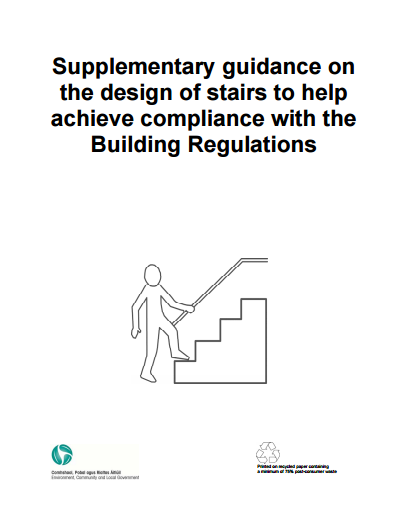



Tgd Part K Supplementary Info On Stairs Property Health Check




Length Of Ramp Required To Comply With Uk Building Regulations Disability News And Advice



0 件のコメント:
コメントを投稿